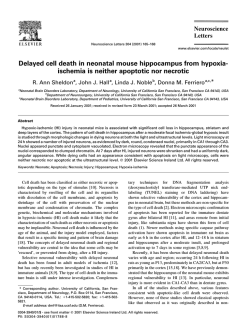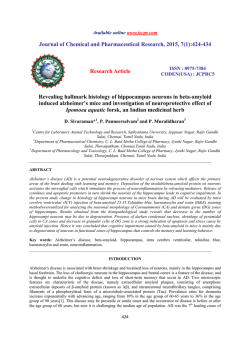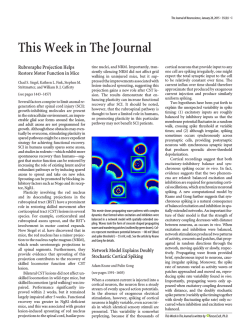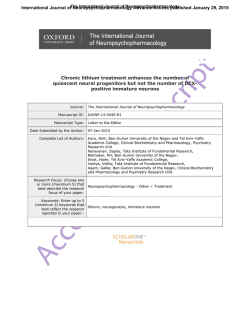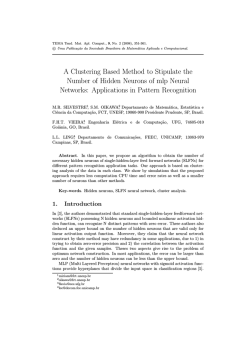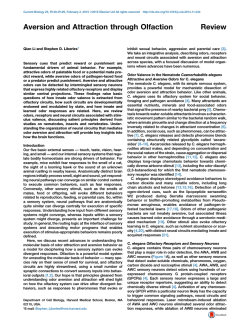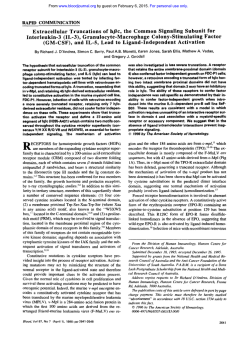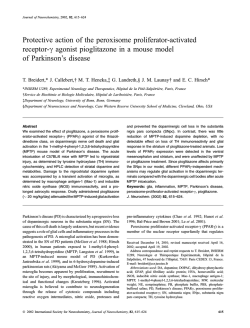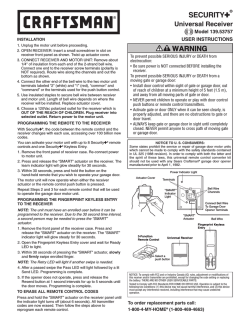
A role for TREM2 ligands in the phagocytosis of
JOURNAL OF NEUROCHEMISTRY | 2009 | 109 | 1144–1156 1 doi: 10.1111/j.1471-4159.2009.06042.x 2 University of California, San Francisco, and the San Francisco VA Medical Center, San Francisco, California, USA Abstract Following neuronal injury, microglia initiate repair by phagocytosing dead neurons without eliciting inflammation. Prior evidence indicates triggering receptor expressed by myeloid cells-2 (TREM2) promotes phagocytosis and retards inflammation. However, evidence that microglia and neurons directly interact through TREM2 to orchestrate microglial function is lacking. We here demonstrate that TREM2 interacts with endogenous ligands on neurons. Staining with TREM2-Fc identified TREM2 ligands (TREM2-L) on Neuro2A cells and on cultured cortical and dopamine neurons. Apoptosis greatly increased the expression of TREM2-L. Furthermore, apoptotic neurons stimulated TREM2 signaling, and an anti-TREM2 mAb blocked stimulation. To examine the interaction between TREM2 and TREM2-L in phagocytosis, we studied BV2 microglial cells and their engulfment of apoptotic Neuro2A. One of our anti-TREM2 mAb, but not others, reduced engulfment, suggesting the presence of a functional site on TREM2 interacting with neurons. Further, Chinese hamster ovary cells transfected with TREM2 conferred phagocytic activity of neuronal cells demonstrating that TREM2 is both required and sufficient for competent uptake of apoptotic neuronal cells. Finally, while TREM2-L are expressed on neurons, TREM2 is not; in the brain, it is found on microglia. TREM2 and TREM2-L form a receptor–ligand pair connecting microglia with apoptotic neurons, directing removal of damaged cells to allow repair. Keywords: apoptotic neurons, microglia, phagocytosis. J. Neurochem. (2009) 109, 1144–1156. Microglia are resident myeloid-derived cells in the CNS that provide constant surveillance of the brain and spinal cord. In a resting state, microglial dendrites display a divergent and branched phenotype, with their protruding processes dynamically sampling and monitoring their environment (Nimmerjahn et al. 2005). As part of the innate immune system, microglia can defend against microbial pathogens, clear injured neurons and cellular debris, and provide sustenance to other cells in the CNS (Aloisi 2001; Napoli and Neumann 2009). Microglia, however, can also promote inflammation, which may exacerbate neurodegenerative diseases, such as Alzheimer’s disease and Parkinson’s disease, as well as ischemic brain injury (Kempermann and Neumann 2003; Minghetti 2005; Yenari et al. 2006; Block et al. 2007). Proinflammatory microglia and macrophages also play a detrimental role during multiple sclerosis, where the importance of specifically inhibiting inflammatory signals from CNS myeloid cells has been clearly elucidated (Prinz et al. 2008). Thus, the functional differentiation of microglia has important consequences for disease. Triggering receptor expressed by myeloid cells-2 (TREM2) is an immunoglobulin-like orphan receptor of the TREM family that is expressed on activated macrophages, immature dendritic cells, osteoclasts, and at least some 1144 Received November 26, 2009; revised manuscript received February 16, 2009; accepted March 12, 2009. Address correspondence and reprint requests to William E. Seaman, VAMC 111R, 4150 Clement St., San Francisco, CA 94121, USA. E-mail: [email protected] 1 The present address of Maya Koike is the University of California, Irvine, Irvine, CA 92623, USA. 2 The present address of Steve Spusta is The Buck Institute, Novato, CA 94945, USA. Abbreviations used: APC, allophycocyanin; CHO, Chinese hamster ovary; CN, cortical neurons; DAP12, DNAX-adaptor protein; DMEM, Dulbecco’s modified Eagle’s medium; EAE, experimental autoimmune encephalitis; FCS, fetal calf serum; GAPDH, glyceraldehyde 3-phosphate dehydrogenase; GFP, green fluorescent protein; NeuN, neuronal nuclei; NFAT, nuclear factor of activated T cells; PBS, phosphate-buffered saline; PMA, phorbol 12-myristate 13-acetate; PE, phycoerythrin; TH, tyrosine hydroxylase; TREM2, triggering receptor expressed by myeloid cells-2; TREM2-L, TREM2 ligand; VMN, ventral midbrain neurons. Journal Compilation 2009 International Society for Neurochemistry, J. Neurochem. (2009) 109, 1144–1156 No claim to original US government works TREM2 ligands on neurons | 1145 microglia (Colonna 2003). TREM2 associates with DNAX adaptor protein-12 (DAP12), a signaling molecule that contains an immunoreceptor tyrosine-based activation motif. Loss-of-function mutations in either TREM2 or DAP12 cause Nasu-Hakola disease, a rare and fatal neurodegenerative disease also known as polycystic lipomembranous osteodysplasia with sclerosing leukoencephalopathy (Paloneva et al. 2000, 2002). Symptoms and consequences of Nasu-Hakola disease include late-onset dementia, demyelination, and cerebral atrophy, with widespread activation of microglia, demonstrating that both TREM2 and DAP12 are critical in maintaining homeostasis of the CNS. The mechanisms of neurodegeneration in this disorder are unknown, but one hypothesis is that lack of either TREM2 or DAP12 impairs the clearance of apoptotic neurons by microglia, leading to the accumulation of necrotic debris (Thrash et al. 2008). Phagocytosis of apoptotic cells is important to prevent leakage of noxious contents, to avert immune responses against self-antigens, and to suppress unwanted immune responses (Ravichandran and Lorenz 2007). DAP12, the signaling partner for TREM2, was originally described as transducing conventional activation signals, but the TREM2–DAP12 complex inhibits some macrophage functions. Depletion of TREM2 either by RNAi or by targeted gene deletion amplifies inflammatory cytokine responses by macrophages following stimulation of toll-like receptors (Hamerman et al. 2005, 2006; Piccio et al. 2007). Furthermore, TREM2 expression in microglia impairs tumor necrosis factor-a and nitric oxide synthase-2 transcript expression even as it increases phagocytosis in response to apoptotic neurons (Takahashi et al. 2005). In mice with experimental autoimmune encephalitis (EAE), blockade of TREM2 with a mAb exacerbates disease, while treatment with TREM2-expressing myeloid cells reduces inflammation and improves disease (Piccio et al. 2007; Takahashi et al. 2007). In sum, these findings support a model in which TREM2 suppresses inflammation and promotes tissue repair through removal of apoptotic cells. Although loss of either TREM2 or DAP12 does not usually have detectable clinical consequences until adulthood, studies in mice also implicate DAP12 in CNS development, as neonatal mice lacking DAP12 have reduced capacity for mediating neuronal cell death during hippocampal development (Wakselman et al. 2008). Although these clinical and experimental studies demonstrate the importance of TREM2 in the brain, ligands for TREM2 have not been identified. In addition, the functional recognition of apoptotic cells by TREM2 has not been described. We have previously shown that TREM2 recognizes anionic patterns of ligands on bacteria and some eukaryotic cells (Daws et al. 2003). We demonstrate here the finding of an endogenous cellular ligand for TREM2 on neurons, and thus have identified a novel pathway of direct communication between microglia and neurons. We show that TREM2 can bind directly to neuronal cells, with increased binding to apoptotic neuronal cells. TREM2 ligands (TREM2-L) on apoptotic neurons mediate signal transduction by TREM2 on microglia and promote phagocytosis. Further, blockade of this interaction between microglia and apoptotic neurons using a TREM2 mAb impairs phagocytosis of apoptotic neurons by microglia. As direct evidence of a role for TREM2 in the phagocytosis of apoptotic neuronal cells we also show that TREM2 transfected Chinese hamster ovary (CHO) cells have increased phagocytosis of dying Neuro2A cells. Our findings support the hypothesis that phagocytosis of apoptotic neurons by microglia is promoted by a novel interaction of TREM2 on microglia with TREM2-L on apoptotic neurons. Materials and methods Animals and surgical procedures Wildtype C57BL/6 mice were obtained from Charles Rivers Laboratories (Wilmington, MA, USA). Male mice (8–12 weeks) were used for histological sections and for isolation of adult microglia. Neonatal mice (days 1–4) were also used to obtain microglia. For experiments examining green fluorescent protein (GFP+) neonatal microglia, cells were derived from heterozygous CX3CR1GFP/+ mice. CX3CR1GFP/GFP mice, which are homozygous knockouts for CX3CR1 with GFP knocked-in were previously described (Jung et al. 2000; Cardona et al. 2006) and obtained from Drs Li Gan and Sharon Haynes (UCSF) with the kind permission of Dr Dan Littman (Skirball Institute). CX3CR1GFP/GFP mice were crossed with wildtype C57BL/6 mice to generate CX3CR1GFP/+ heterozygous animals, which coexpress CX3CR1 and GFP in their microglia. Animals were housed at the San Francisco VA Animal Facility, an AAALACapproved facility, and were used under approved protocols. Antibodies To detect microglia, allophycocyanin (APC) or phycoerythrinconjugated anti-CD11b (Clone M1/70) and anti-CD45 (Clone Ly5) FITC antibodies were used (eBioscience, San Diego, CA, USA). Our production of rat anti-mouse TREM2 mAbs has been described (Humphrey et al. 2006). Isotype controls for the TREM2 antibodies were rat IgG2a (for Clones 67.8, 69.2, 150.1, and 181.1) and functional grade rat IgG1 (for Clone 78.18) (BD Biosciences, San Jose, CA, USA). For detection of TREM2 on primary cells, primary antibody staining was amplified with a biotin-conjugated goat antirat Fab antibody (1 : 400; Jackson Immuno Research, West Grove, PA, USA) followed by either streptavidin–Cy3 (1 : 150) (Sigma, St Louis, MO, USA) for microscopy, or by streptavidin–APC (Caltag, Carlsbad, CA, USA) for flow cytometry. To detect TREM2 on cell lines by flow cytometry, a secondary donkey anti-rat phycoerythrin or APC-conjugated F(ab¢)2 antibody (Jackson Immunolabs) was used. TREM1 on CHO cells was detected by using an anti-TREM1 biotin-conjugated antibody (R&D Systems, Minneapolis, MN, USA) followed by streptavidin–APC. Dopaminergic neurons were identified by antiserum to tyrosine hydroxylase (TH) (Chemicon, Billerica, MA, USA), and all neurons were detected by staining for alexa-fluor488-conjugated neuronal nuclei (NeuN) (1 lg/mL; Chemicon) or for neuronal class III b-tubulin (Covance, Princeton, NJ, USA). To stain for TREM ligands by flow cytometry, TREM2- Journal Compilation 2009 International Society for Neurochemistry, J. Neurochem. (2009) 109, 1144–1156 No claim to original US government works 1146 | C. L. Hsieh et al. Fc or TREM1-Fc proteins (R&D Systems) were used and detected by a donkey anti-human F(ab¢)2 APC-conjugated antibody (Jackson Immunolabs). Both TREM fusion proteins were validated by western blot to contain both their respective TREM receptor and the Fc domain of human IgG1. Cell culture and isolation BV2, Neuro2A, BWZ, WEHI-231, P388D1, and Chinese Hamster Ovary (CHO) cells were cultured in Roswell Park Memorial Institute 1640 (Cellgro, Manassus, VA, USA) with 10% fetal bovine serum (Atlanta Biologicals, Lawrenceville, GA, USA), 1% penicillin/ streptomycin (Gibco, Carlsbad, CA, USA), and 50 lM 2 mercaptoethanol (Sigma). The derivation of CHO cells expressing a chimeric TREM2/DAP12 receptor or a chimeric TREM1/DAP12 receptor has been previously described (N’Diaye et al. 2009). Cell death was induced in Neuro2A cells by treatment with either the kinase inhibitor staurosporine (0.5 lM) or the neurotoxin MPP+ (7.5–15 mM) for 16 h (Sigma). Apoptosis was induced in BWZ, WEHI-231, and P388D1 cells with 0.25–0.4 lM staurosporine for 16 h. Following treatment with staurosporine or MPP+, cells were 40–60% Annexin V+ and propidium iodide+ (BD Biosciences) as assessed by flow cytometry. TREM2-L expression was analyzed on Annexin V) PI), Annexin V+ PI), and Annexin V+ PI+ cell populations. For isolation of primary cultured neonatal microglia, whole brains were harvested from mouse pups and were stripped of meninges. Tissue was mechanically dissociated through a 100 lm cell strainer and the resulting cell suspension was washed and plated in culture medium [Dulbecco’s modified Eagle’s medium (DMEM) high glucose; Cellgro], 10% fetal bovine serum, 1% penicillin/ streptomycin, 1% GlutaMAX (Invitrogen, Carlsbad, CA, USA), 8 lM HEPES, and 10 lg/mL insulin (Invitrogen). Supernatants were transferred after 3–4 days to a new flask, and fresh medium was added to all cells. Mixed glial cells were cultured for 10– 21 days, with 1–2 media changes/week. Where indicated, neonatal microglia were sorted to 99% purity using an anti-CD11b antibody and a FACSAria (BD Biosciences). Primary adult microglia were isolated according to previously published methods (Sedgwick et al. 1991). Briefly, following perfusion, brains and spinal cords were obtained and gently dissociated through a 100 lm cell strainer. Washed cells were treated at 37C for 30 min with 400 U/mL Dnase (Sigma) and 0.5 mg/mL collagenase type I (Worthington, Lakewood, NJ, USA). Leukocytes were isolated by separation on a Percoll gradient (Amersham Biosciences, Piscataway, NJ, USA). Primary cortical neurons (CN) were isolated from mice at embryonic day 16. Cortices were incubated with 0.12% trypsin for 10 min at 37C and washed three times with DMEM containing 10% fetal calf serum (FCS). Tissue was triturated and cells were plated at 0.3 · 106 cells/mL onto poly-D-lysine-coated plastic in Neurobasal medium supplemented with B27 (Invitrogen), 1% penicillin/streptomycin, and 1% GlutaMAX. In some cases, 3 lM araC was used at day 1 for 24 h to inhibit the growth of glia. CN were cultured for 7–10 days and were greater than 90% NeuN+. Ventral midbrain neurons (VMN) were isolated from embryos at day 13.5. Ventral midbrain tissue was trypsinized (1%; Worthington) for 15 min at 37C, quenched with medium containing 20% horse serum, washed, and triturated. Cells were plated at 30 000 or 100 000 cells/well in 96- or 24-well plates, respectively, onto poly- D-lysine and laminin (Sigma) coated surfaces. VMN were cultured in DMEM/F12 containing 2.2% Albumax (Invitrogen), and 1% N1 additive (Sigma). VMN were used for experiments at day 1. The cultures contained 3–4% dopaminergic neurons and the entire culture was nearly 100% neuronal. The generation of CHO cells transfected with chimeric TREM2/ DAP12 or TREM1/DAP12 has been described (N’Diaye et al. 2009). Cytochemistry, immunofluorescence confocal microscopy, and histology For examination of TREM2-L expression on isolated CN and VMN, cells were fixed with 3.7% p-formaldehyde (Ted Pella, Inc., Redding, CA, USA) in phosphate-buffered saline (PBS) for 15 min, blocked with 5% goat and mouse sera, and stained with either TREM2b-Fc or TREM1-Fc chimeras (1 lg/mL). To detect the human IgG1 Fc domain of the TREM-Fc fusion proteins, a biotinconjugated goat anti-human F(ab¢)2 antibody (Jackson Immunolabs) followed by an immunoperoxidase reaction (ABC elite kit; Vectorlabs, Burlingame, CA, USA) was used. Images were taken using an inverted microscope. To analyze TREM2 expression by immunofluorescence microscopy of cultured cells, sorted neonatal microglia were plated onto poly-D-lysine-coated glass coverslips (BD Biosciences) and fixed with 3.7% p-formaldehyde. Cells were blocked with 5% goat serum and stained for TREM2 using a cocktail of five anti-TREM2 antibodies (1 lg/mL of each antibody) overnight at 4C. After washing in PBS and a second round of blocking, a secondary antibody was applied for 1 h at 20–25C. After washing, cells were stained with streptavidin–Cy3 for 1 h. Cells were stained with 4¢,6diamidino-2-phenylindole for 5 min and mounted onto glass slides with Permount (Fisher, Pittsburgh, PA, USA). Images were visualized with an LSM510 laser scanning confocal microscope (Zeiss, Thornwood, NY, USA). Single optical sections with a thickness of < 1.0 lm were imaged with a 60· magnification lens with oil. White scale bars represent a 10 lm distance. For histology, mice were killed and subjected to cardiac perfusion. Harvested brains and spinal cord tissues were incubated in increasing concentration (15–30%) of sucrose until saturated and then frozen in tissue-freezing medium. Sections (10 lm) were obtained and mounted onto Superfrost glass slides (Fisher). Tissue was fixed and permeabilized with 75% ethanol/25% methanol for 10 min and stained and imaged as above for TREM2. Tissue was incubated in a blocking solution containing 5% rat and mouse serums, and stained for CD11b and NeuN. Triggering receptor expressed by myeloid cells-2 reporter assay BWZ thymoma reporter cells, which express lacZ under control of the promoter for nuclear factor of activated T cells (NFAT), were a generous gift from Dr Nilabh Shastri (UC Berkeley). BWZ cells were transfected to coexpress TREM2 and DAP12. One positive clone was designated BWZ.TREM2/DAP12. BWZ.TREM2/DAP12 cells or, as a control, parental BWZ cells were plated at 1 · 106 cells/mL on top of neuronal target cells that had been left untreated or treated with the apoptotic stimulus MPP+ in triplicate in assay medium [Roswell Park Memorial Institute, 1% FCS, and 20 ng/mL phorbol 12-myristate 13-acetate (PMA)]. Neuro2A cells were treated with 7.5–15 mM MPP+ and primary neurons were treated with 300 lM MPP+ overnight and washed. As a positive control, Journal Compilation 2009 International Society for Neurochemistry, J. Neurochem. (2009) 109, 1144–1156 No claim to original US government works TREM2 ligands on neurons | 1147 ionomycin (3 lM) was added to reporter cells alone. Reporter cells were stimulated by fresh or apoptotic cells for 16 h at 37C, washed, and lysed in a buffer containing 100 mM 2-mercaptoethanol, 9 mM MgCl2, 0.125% NP-40 (Sigma), and 30 mM chlorophenol red galactosidase. Plates were developed for 24 h at 37C, and lacZ activity was measured as previously described (Sanderson and Shastri 1994). Statistical significance was determined using unpaired two-tailed Student’s t-test and PRISM software (GraphPad, San Diego, CA, USA). Lentiviral-mediated shRNA Lentivirus encoding for a TREM2 shRNA sequence (5¢-GAAGCGGAATGGGAGCACA-3¢) (TREM2 shRNA-GFP 3.7) or a control empty virus (GFP 3.7) was produced by Fugene (Roche, Indianapolis, IN, USA)-mediated co-transfection of 293T cells with pREV, pVSVg, pMDL, and the pLenti-GFP 3.7 plasmid containing the shRNA sequence. Effector BV2 cells were plated in 24-well plates at 100 000 cells/well overnight. Medium was replaced and cells were treated with 8 lg/mL polybrene. Filtered and concentrated virus was applied to cells that were then spun at 1000 g for 90 min at 20–25C and then cultured for 24 h at 37C. Knockdown of TREM2 was determined at 72 h, and cells were used for phagocytosis assays. Phagocytosis assay BV2 or CHO effector cells (100 000 cells/well) were plated in 24-well plates overnight. Cytochalasin D (2 lM; Sigma), rat IgG1 (100 lg/mL), or anti-TREM2 blocking antibody (100 lg/mL, Clone 78.18) was added for 20 min at 20–25C in fresh medium. Target Neuro2A cells were labeled with CM-DiI (Invitrogen) and cultured overnight in low-cluster wells with or without 0.5 lM staurosporine to induce apoptosis. Untreated or apoptotic Neuro2A cells were washed several times, and then plated with effector cells at 1 : 10 E : T. Red fluorescent polystyrene microspheres (1.0 lm) (Invitrogen) were washed and plated on BV2 cells at a 1 : 50 E : T. Plates were spun for 3 min at 400 g and incubated for ‡ 1 h at 37C. Cells were washed thrice with ice-cold PBS and harvested with 0.25% trypsin. Cells were immediately transferred into ice-cold flow cytometry buffer (PBS, 0.02% azide, and 1% FCS) and kept on ice. In all samples, BV2 cells were distinguished from neuronal cells and beads by anti-CD11b APC antibody (eBioscience), and histogram gates for CD11b+ cells were drawn based on effector cells cultured without target cells (not shown). Phagocytosis was quantified as follows: (percent CM-DiI+ or red effector cells ) percent of CM-DiI+ or red effector cells treated with cytochalasin D)/percent CM-DiI+ or red effector cells) ± SEM. Statistical significance was determined using unpaired two-tailed Student’s t-test and PRISM software. Semi-quantitative real-time PCR Adult murine microglia were sorted by flow cytometry for CD45loCD11b+ parameters. Total RNA was isolated by using TRIzol (Invitrogen), and cDNA was synthesized using Superscript III reverse transcriptase with oligo dT primers (Invitrogen). Amplification of TREM2 cDNA used the following primers: 5¢GCACCTCCAGGAATCAAGAG-3¢, 5¢-GGGTCCAGTGAGGATCTGAA-3¢. For glyceraldehyde 3-phosphate dehydrogenase (GAPDH) primers were: 5¢-ATTCAACGGCACAGTCAAGG-3¢, 5¢-TGGTTCACACCCATCACAAA-3¢. PCR was performed using an ABI 7500 (Applied Biosystems, Foster City, CA, USA) real-time PCR machine. SYBR green (New England Biolabs, Ipswich, MA, USA) was used to quantify the amplifications, and levels of TREM2 transcripts were normalized to GAPDH controls. Results Neurons express ligands for TREM2 that are increased by apoptosis Receptors and ligands involved in phagocyte recognition of apoptotic cells are still being unveiled. Because TREM2 on microglia has been shown to be important for the phagocytosis of apoptotic neurons (Takahashi et al. 2005), we tested the hypothesis that TREM2 directly recognizes a ligand on neurons that facilitates engulfment. To address this, we studied the neuronal cell line, Neuro2A and primary cultured embryonic mouse cortical and VMN. We first examined these cells for the expression of TREM2-L by staining them with a TREM2-Fc fusion protein or, as a control, a TREM1Fc control fusion protein. The chimeric proteins consist of the extracellular domains of the TREM receptor fused to the Fc domain of human IgG1, mutated to reduce binding to Fc receptors. By cytochemistry, staining with these soluble receptors demonstrated that both Neuro2A cells and fresh neuronal cells bind to TREM2-Fc but not TREM1-Fc (Fig. 1). Microgliosis has been implicated in the pathogenesis of Parkinson’s disease, a neurological disorder characterized by degeneration of TH+ dopaminergic neurons in the substantia nigra pars compacta (Minghetti 2005; Block et al. Fig. 1 Neuronal cells express ligands for TREM2. Neuro2A cells (top), primary cortical neurons (middle), and primary ventral midbrain neurons (bottom) were cultured and stained for TREM2-L expression by cytochemistry, using a soluble TREM2-Fc fusion protein. All neuronal cells examined bound soluble TREM2 (brown), but not TREM1 (right column). Data are representative of at least three experiments for each cell type. Journal Compilation 2009 International Society for Neurochemistry, J. Neurochem. (2009) 109, 1144–1156 No claim to original US government works 1148 | C. L. Hsieh et al. 2007). To specifically pursue the possibility that dopaminergic neurons might communicate with microglia through TREM2, we assessed whether dopaminergic neurons in ventral midbrain cultures expressed TREM2-L. By fluorescence microscopy, TREM2-L was detected on all VMN, including the TH+ neurons (data not shown). These data (a) suggest that multiple cultured neuronal cells express a potential ligand for TREM2. To assess the effects of apoptosis on the expression of TREM2-L by neuronal cells, we used flow cytometry to stain Neuro2A cells with soluble TREM2-Fc before and after induction of apoptosis by MPP+ or staurosporine. Consistent (c) (b) Fig. 2 Apoptosis increases the expression of functional TREM2-L on neuronal and non-neuronal cells. (a) TREM2-L expression was quantified by flow cytometry before (left) and after (right) induction of apoptosis in Neuro2A cells by staurosporine (sts) or MPP+. The median fluorescence intensity of TREM2-Fc or TREM1-Fc binding of each gate is shown. Apoptotic Neuro2A cells (Annexin Vhi) express 3- to 10-fold greater levels of TREM2-L compared with Annexin Vlo Neuro2A cells, but do not express TREM1-L (n = 7). (b) TREM2-L expression is increased on non-neuronal cells during apoptosis. BWZ, WEHI-231, and P388D1 cells bind to TREM2-Fc, but not TREM1-Fc. Treatment with staurosporine boosts TREM2-Fc binding to Annexin Vhi cells by 7- to 10fold (n = 3). (c) Neuronal cells activate TREM2/DAP12 signal transduction as assessed by BWZ.TREM2/DAP12 reporter cells. Healthy Neuro2A cells induce a modest level of cellular activation in the BWZ.TREM2/DAP12 cell line, and this is increased to near-maximal levels when the Neuro2A are treated with MPP+ to induce apoptosis (top panel). Pre-treating the BV2 cells with a blocking TREM2 mAb (black bars), but not with a control rat IgG1 mAb (gray bars), significantly reduces cellular activation in response to both untreated and apoptotic Neuro2A cells. Ventral midbrain neurons (VMN) elicit similar responses (third panel), while cortical neurons (CN) demonstrate little stimulation unless they are apoptotic (second panel). BWZ.TREM2/DAP12 reporter cell activation in response to primary neurons was effectively blocked with the TREM2 mAb. None of the neuronal cells activate the parental BWZ reporter cell line (representative results for VMN are shown in the bottom panel); *p < 0.05, **p < 0.005, and ***p < 0.0005. Journal Compilation 2009 International Society for Neurochemistry, J. Neurochem. (2009) 109, 1144–1156 No claim to original US government works TREM2 ligands on neurons | 1149 with our cytochemistry data, Neuro2A cells bound TREM2-Fc but not TREM1-Fc (Fig. 2a). Notably, induction of apoptosis in Neuro2A cells with MPP+ or staurosporine resulted in a 5- to 10-fold increase in the median fluorescence intensity of TREM2-L expression on the Annexin Vhi cells (Fig. 2a). These data indicate that apoptosis increases the expression of TREM2-L on neurons, presenting a potential mechanism for enhancing their clearance by TREM2+ microglia. TREM2-L is also increased on non-neuronal apoptotic cells Ligands for TREM2 are not exclusively expressed on neurons. We have previously shown that mouse TREM2 binds to human astrocytoma cell lines, and our colleagues have previously reported potential TREM2-L expressed on macrophages (Daws et al. 2003; Hamerman and Lanier 2006). To test whether cells other than neurons also have enhanced TREM2-L expression during apoptosis, we induced cell death in multiple murine cell lines using staurosporine. Untreated BWZ thymoma cells, WEHI-231 B cell lymphoma cells, and P388D1 macrophage-derived cells all expressed low levels of TREM2-L on the Annexin Vnegative population (Fig. 2b). Similar to the Neuro2A cells, administration of staurosporine to BWZ, WEHI-231, or P388D1 cells heightened their binding of TREM2-L by 7- to 10-fold, while TREM1-Fc binding remained unaffected (Fig. 2b). Other murine cell lines such as B16s melanoma and RAW 264.7 macrophages were also tested and showed similar results (not shown). These data suggest that upregulation of TREM2-L during apoptosis is a common cellular phenomenon. TREM2-L on neuronal cells activate the TREM2/DAP12 receptor complex To determine if TREM2-L on neuronal cells can functionally engage TREM2 and initiate intracellular signaling, we utilized a TREM2 reporter cell line. This was constructed from BWZ cells, a thymoma expressing the gene for b-galactosidase under the control of multiple copies of the NFAT promoter element (Sanderson and Shastri 1994). We expressed both TREM2 and DAP12 in this line (BWZ.TREM2/DAP12 cells), anticipating that functional perturbation of TREM2 by ligands would lead to the phosphorylation of DAP12, and the consequent activation of the NFAT reporter, and production of b-galactosidase. We first assessed stimulation of the BWZ.TREM2/DAP12 reporter line by healthy or apoptotic Neuro2A cells. Untreated Neuro2A cells stimulated the BWZ.TREM2/DAP12 reporter cell above the PMA alone control (Fig. 2c). Strikingly, however, apoptotic Neuro2A cells stimulated the reporter cell line much more, to a level comparable to maximal excitation by PMA and ionomycin, whether cell death was induced by the MPP+ neurotoxin or by serum-starvation (apoptotic vs. untreated Neuro2A, p = 0.0001). This response was specifically mediated by TREM2 as assessed by two means. First, BWZ cells lacking TREM2 and DAP12 did not respond to healthy or apoptotic neuronal cells. Second, stimulation of the TREM2/DAP12 reporter cells by Neuro2A or apoptotic Neuro2A cells was partially blocked by one of our antiTREM2 mAb (Clone 78.18) (black bars), but stimulation was unaffected by an isotype control mAb (rat IgG1) (gray bars) (p-values of blockade < 0.05). Stimulation of the reporter cells with the anti-TREM2 antibody alone did not induce activation (not shown). We also attempted to block TREM2 by using other anti-TREM2 mAbs in our panel (data not shown), but only Clone 78.18 inhibited TREM2 activation. These results suggest that the 78.18 mAb may specifically block a binding site engaged by TREM2-L. Alternatively, this mAb may inactivate TREM2 in a manner not mimicked by our other mAbs. We next tested whether primary neurons, particularly apoptotic primary neurons, could also activate TREM2. VMN activated TREM2 and this activity was fully impaired by the anti-TREM2 mAb (Fig. 2c). Healthy cortical neurons had less effect on TREM2 stimulation, although activation was again completely inhibited with the anti-TREM2 mAb (p < 0.005) (Fig. 2c). Like apoptotic Neuro2A cells, apoptotic primary neurons, either cortical or from the ventral midbrain, more effectively activated the TREM2/DAP12 reporter cells, and this activation was fully impaired by the anti-TREM2 mAb (p < 0.05) (Fig. 2c). None of the neuronal cells activated the parental BWZ cell line (Fig. 2c, results for VMN are shown). In addition, reporter cell activation required cell–cell contact, because supernatants from apoptotic neuronal cells did not activate the BWZ.TREM2/ DAP12 reporter (not shown). Thus, apoptotic neuronal cells bind to TREM2, and they activate signal transduction through the TREM2–DAP12 complex. Phagocytosis of apoptotic neuronal cells is inhibited by antibody to TREM2 As a model for microglial phagocytosis of neurons, we studied the uptake of Neuro2A neuroblastoma cells by BV2 murine microglial cells. For these studies, Neuro2A cells were labeled with the red fluorescent dye CM-DiI, and apoptosis was initiated by treatment with staurosporine. After 1 h, about 30% of the BV2 microglial cells engulfed fluorescent material from the Neuro2A cells as detected by flow cytometry (Fig. 3a). This did not reflect non-specific binding, because pre-treatment of the BV2 cells with 2 lM cytochalasin D, a cytoskeletal inhibitor, abrogated phagocytosis. To confirm by microscopy the uptake of fluorescent cell particles by BV2 microglia (labeled with CD11b-APC, blue), confocal images of single optical sections were taken of the effector cells following coincubation with CM-DiI-labeled Neuro2A cells at a 1 : 10 E : T ratio. Untreated BV2 cells showed uptake of CM-DiI+ particles, but BV2 cells treated with cytochalasin D did not (Fig. 3a). Using sections of < 1 lm transversing the nuclei, the neuronal particles were intracellular and they were not Journal Compilation 2009 International Society for Neurochemistry, J. Neurochem. (2009) 109, 1144–1156 No claim to original US government works 1150 | C. L. Hsieh et al. removed by washing, evidence that they did not represent particles on the cell surface. It has previously been shown that TREM2 expression on microglia promotes phagocytosis (Takahashi et al. 2005). To confirm this in our system, BV2 microglial cells were transduced with shRNA targeted for TREM2, which reduced surface expression of TREM2 by 50–84% as detected by flow cytometry (Fig. 3b, left), and it reduced phagocytosis compared with empty virus infected BV2 cells (Fig. 3b, right) (n = 6). To determine if the requirement for TREM2 in phagocytosis reflects engagement of the extracellular TREM2 domain (a) (b) (c) (d) Journal Compilation 2009 International Society for Neurochemistry, J. Neurochem. (2009) 109, 1144–1156 No claim to original US government works TREM2 ligands on neurons | 1151 with putative TREM2-L on neuronal cells, we first performed phagocytosis assays using BV2 microglial cells in the presence of the blocking TREM2 mAb or with an isotype control mAb. BV2 cell uptake of CM-DiI-labeled apoptotic Neuro2A cells was diminished in the presence of the TREM2 mAb, but not with the isotype control (Fig. 3c). Representative flow cytometric histograms are shown (Fig. 3c, left), and a summary of multiple experiments (n = 6) examining the effect of blocking TREM2 and TREM2-L interactions on phagocytosis is also shown (Fig. 3c, right). Untreated BV2 cells or isotype control BV2 cells showed comparable levels of phagocytosis, 39 ± 3% and 37 ± 2%, respectively. Pretreatment of the BV2 cells with the anti-TREM2 blocking mAb decreased the number of cells in which phagocytosis could be detected to 24 ± 1%, which is 38% less than untreated cells and 35% less than cells treated with control mAb (p = 0.005 and 0.0002, respectively). Blockade of phagocytosis by an anti-TREM2 mAb supports the hypothesis that direct recognition by TREM2 of its ligands on neuronal cells is important for efficient phagocytosis by microglial cells. Blockade of phagocytosis by the antiTREM2 mAb is incomplete, however. This may be partially explained by the inability of the antibody to completely block the activation of TREM2 by its ligands on Neuro2A cells as shown in the reporter cell assays (Fig. 2c). Alternatively, other interactions may contribute to microglial phagocytosis of apoptotic neuronal cells in a manner that is independent of TREM2. To test whether TREM2 expression directs only clearance of apoptotic cells or whether it broadly enhances phagocytosis, we performed phagocytosis assays examining the uptake of red fluorescent microspheres by BV2 cells with and without TREM2. TREM2 expression in BV2 cells was inhibited by using the TREM2 shRNA lentivirus. In contrast to the reduction in phagocytosis of apoptotic neurons (bottom TREM2 is sufficient to induce phagocytosis of apoptotic neuronal cells by Chinese hamster ovary cells CHO cells do not express known phagocytic receptors, and gene transfection into these cells has been used to demonstrate the engulfment activity of phagocyte receptors, such as CR3 and FcR gamma (Nagarajan et al. 1995; Le Cabec et al. 2002). To determine whether the presence of TREM2 is sufficient for phagocytosis of neuronal cells, we analyzed the phagocytic activity of CHO cells that had been transfected to express either TREM2 or TREM1. In this system, TREMs are directly coupled to the cytoplasmic domain of DAP12, and these TREM/DAP12 chimeric receptors were previously shown to permit TREM-mediated signaling through DAP12 (Hamerman et al. 2006). The TREM2-transfected CHO cells have recently been used to demonstrate that TREM2 is sufficient to bestow CHO cells with the ability to internalize bacteria (N’Diaye et al. 2009). We therefore tested whether the over-expression of TREM2 or TREM1 in CHO cells would similarly confer phagocytic activity of apoptotic neuronal cells. The plasmids also express GFP, and GFP expression was a faithful marker of TREM receptor expression, as both the CHO.TREM2/ DAP12 and CHO.TREM1/DAP12 cell lines expressed their respective receptor on cells gated for GFP (Fig. 4, left). Assessment of phagocytosis by CHO.TREM2/DAP12, CHO.TREM1/DAP12, and the parental CHO cell line for engulfment of apoptotic Neuro2A cells demonstrated that Fig. 3 TREM2/TREM2-L interactions are important for phagocytosis, and TREM2 is required for efficient phagocytosis of apoptotic neuronal cells but not of beads. (a) Phagocytosis of apoptotic Neuro2A cells (> 40% Annexin Vhi) by BV2 microglial cells cocultured at an E : T of 1 : 10 as assessed by flow cytometry (left column) or fluorescence confocal microscopy (right panels). Histograms indicate the percent of BV2 cells that have internalized CM-DiI-labeled staurosporine-treated Neuro2A cells during 1 h assays. Images of single optical sections (< 1 lm) were obtained by confocal microscopy with a 60· magnification lens of BV2 cells labeled with an APC-conjugated anti-CD11b mAb (blue) and cocultured with CM-DiI+ apoptotic Neuro2A cells (red). Images indicate uptake of neuronal debris by BV2 cells. Phagocytosis is inhibited by cytochalasin D in both assays. Scale bars, 10 lm. (b) Phagocytosis of apoptotic Neuro2A cells is reduced in BV2 cells following lentiviral-mediated RNAi against TREM2. RNAi reduced the surface expression of TREM2 up to 84% as detected by flow cytometry (left). Quantification of 6 experiments shows that phagocytosis by BV2 cells deficient in TREM2 is reduced to 15 ± 5% (mean ± SEM) from 36 ± 5% for untreated BV2 cells and from 34 ± 5% for BV2 cells transduced with empty virus (*p < 0.05) (right). (c) A mAb to TREM2 partially but significantly inhibits phagocytosis of apoptotic Neuro2A cells by BV2 microglia. Representative flow cytometric histograms assessing phagocytosis in the presence of a blocking TREM2 mAb (Clone 78.18) or an isotype control mAb (rat IgG1) is shown (left). Summary of 6 experiments, showing a reduction to 23.7 ± 0.9% of effector cells engulfing targets compared with untreated (34.8 ± 2.9%) and control mAb (36.7 ± 2.1%) treated BV2 cells (right). The TREM2 mAb partially decreases phagocytosis by 32–35%. (**p £ 0.005 and ***p £ 0.0005). (d) Reduction of microglial TREM2 by RNAi does not reduce BV2 phagocytosis of microspheres (here at 1 : 50 E : T ratio, top row), although the same cells again show a loss of phagocytosis of apoptotic Neuro2A cells at 1 : 10 E : T (sts N2A, bottom row) during 1 h assays. BV2 cells were left untreated or subjected to cytochalasin D or infected with TREM2 shRNA or empty virus. Representative flow cytometric histograms are shown (n = 2). row), the phagocytosis of microspheres at an E : T of 1 : 50 (top row) remained unchanged in the same experiments following reduction of TREM2 expression (Fig. 3d). Phagocytosis of beads was also examined at 1 : 80, 1 : 100, and 1 : 250 ratios with similar results (data not shown). Thus, TREM2 is not essential for all phagocytosis but is important for the efficient clearance of apoptotic neurons. Journal Compilation 2009 International Society for Neurochemistry, J. Neurochem. (2009) 109, 1144–1156 No claim to original US government works 1152 | C. L. Hsieh et al. Fig. 4 TREM2 is sufficient to confer phagocytosis of apoptotic Neuro2A. CHO cells stably transfected to express TREM2/DAP12 or TREM1/DAP12 chimeras were assessed for their phagocytosis of apoptotic Neuro2A cells. Flow cytometry confirmed that the transfected CHO cells express either TREM2 (filled histogram, left) or TREM1 (filled histogram, middle) on cells gated for GFP, while isotype controls (open histograms) did not bind to the CHO cells. The expression of TREM2/DAP12 (black bar) was sufficient to increase phagocytosis of apoptotic Neuro2A cells by 1.7-fold over untransfected cells CHO cells (white bar), while expression of TREM1/DAP12 did not (gray bar) (n = 8, *p < 0.05). expression of TREM2/DAP12 increased phagocytosis, but expression of TREM1/DAP12 did not (Fig. 4, right). These findings strongly support the hypothesis that a direct interaction between TREM2 and ligands on neuronal cells mediates phagocytosis. neuronal-specific nuclei (NeuN) marker (blue). Thus, of 349 NeuN+ neurons analyzed none of them expressed detectable TREM2. To examine brain cells for surface expression of TREM2, we used flow cytometry to stain isolated neonatal brain cells with anti-TREM2 mAbs. Neonatal brain cells were examined because microglia can be more easily cultured from neonatal brains, and because of evidence that DAP12 and possibly TREM2 may play an important role in the developing CNS (Wakselman et al. 2008). To facilitate the identification of microglia, and to isolate microglia without the use of antibodies that could affect the cells, we used CX3CR1GFP/+ mice in which one of the genes for CX3CR1 (also known as the fractalkine receptor) is replaced by the gene for green fluorescence protein (GFP). It has previously been shown in these mice that all microglia coexpress functional CX3CR1 and GFP (Jung et al. 2000). Cultured neonatal microglia (GFP+ CD11b+) expressed low, but detectable levels of TREM2 on the surface (Fig. 5c, right). Notably, the expression of TREM2 showed a single peak, i.e. TREM2 did not distinguish two or more distinct populations of microglia, although the lower end of the TREM2 expression profile was not distinguishable from background. TREM2 expression was clearly not found on the non-microglial cells, which include astrocytes. Staining of TREM2 on cultured microglia was also confirmed by using a different anti-TREM2 mAb (Clone 150.1) and the expression profiles were nearly identical (not shown). To confirm the expression profile of TREM2 on cultured microglia, GFP+ cells from CX3CR1GFP/+ mice were sorted by flow cytometry, as gated in Fig. 5c, allowed to adhere to coverslips overnight, and examined by immunofluorescence confocal microscopy for TREM2 expression. In accord with the results obtained by flow cytometry, most neonatal microglia had detectable TREM2 on the surface, and on some this was relatively abundant (Fig. 5d). Although TREM2 protein was expressed TREM2 is found only on microglia in the normal murine CNS The cellular profile of TREM2 expression is important in understanding both the role of TREM2 in the CNS, and the defects leading to Nasu-Hakola disease. All studies of microglia confirm the expression of TREM2 on at least a portion of microglia in vivo (Schmid et al. 2002) and in vitro (Takahashi et al. 2005; Piccio et al. 2007). Some studies, however, have also found expression of TREM2 on cortical neurons and oligodendrocytes (Sessa et al. 2004; Kiialainen et al. 2005). Having shown that neurons express a ligand for TREM2, we therefore examined both cell lines and tissue sections to determine whether neurons or other cells in the CNS indeed also expressed the TREM2 receptor. Semi-quantitative real-time PCR analysis for TREM2 transcripts was performed on Neuro2A cells, BV2 cells, and fresh adult murine microglia sorted to 99% purity for CD45loCD11b+ parameters. Neuro2A cells did not express TREM2, while BV2 cells and primary microglia expressed abundant amounts of TREM2 transcript (Fig. 5a). TREM2 protein expression in the CNS in vivo was determined by histological analysis of fresh-frozen healthy wildtype C57BL/6 adult mouse brain sections using a panel of specific rat anti-mouse TREM2 mAbs. Of 123 CD11b+ cells examined, 111 (90%) expressed detectable TREM2 and these were the only TREM2+ cells found. TREM2 (Fig. 5b, red) was found to colocalize with CD11b+ (green) cells in the cortex, hippocampus (CA1 and dentate gyrus regions), putamen, and spinal cord, but TREM2 did not colocalize with neuronal soma that stained with an antibody against the Journal Compilation 2009 International Society for Neurochemistry, J. Neurochem. (2009) 109, 1144–1156 No claim to original US government works TREM2 ligands on neurons | 1153 (a) (b) (c) (d) along the entire cell membrane on a majority of the microglia, on a portion of the cells TREM2 was detectable only in patches. Almost all cultured neonatal microglia express some level of TREM2 on the cell surface. Discussion In microglia, it has been previously demonstrated that TREM2 promotes phagocytosis of apoptotic neurons without up-regulation of antigen presentation molecules or tumor necrosis factor-a transcripts, but a role for target recognition by TREM2 had not been elucidated (Takahashi et al. 2005). Thus, TREM2 might have bound to a stimulatory molecule on the microglia themselves, or may simply have facilitated the recruitment of DAP12 to a signaling complex during phagocytosis. In contrast, our current studies provide com- Fig. 5 TREM2 is not expressed by normal adult neurons but is expressed by adult and neonatal microglia. (a) Semi-quantitative RT-PCR analysis for TREM2 using cDNA from Neuro2A neuroblastoma cells, BV2 microglial cells, and sorted adult microglia (CD45lo CD11b+). TREM2 transcript levels are normalized to GAPDH RNA levels. Transcripts for TREM2 are not found in Neuro2A cells, but are strongly expressed in BV2 cells and microglia. (b) Immunofluorescence confocal microscopy of histologic sections from brains of normal adult C57BL/6 mice to determine TREM2 expression in the brain. Single optical sections of < 1 lm were imaged at 60· magnification from the cortex, hippocampus (CA1 and dentate gyrus regions), putamen, and spinal cord tissues. A TREM2 mAb cocktail (red) colocalized with CD11b (green) on microglia, but not with neuronal soma as detected by an antibody to NeuN (blue) in neurons. Scale bars, 10 lm. (c) Flow cytometric analysis of TREM2 on cultured neonatal microglia. Mixed glial cells were cultured from CX3CR1GFP/+ mice. TREM2 is expressed on microglia (GFP+CD11b+), but not on non-microglial (GFP) CD11b)) cells, which include astrocytes. (d) Immunofluorescence confocal microscopy images of neonatal microglia isolated from CX3CR1GFP/+ mice and sorted for GFP. TREM2 is detected on nearly all microglia, although the expression level varies from one small patch of TREM2 on the cell membrane to expression around the entire cell membrane. Single optical sections (< 1 lm) at 60· magnification were imaged. Scale bars, 10 lm. pelling evidence that microglial phagocytosis of apoptotic neurons involves direct recognition by TREM2 on microglia with ligands that are up-regulated on apoptotic neurons. When neuronal cells undergo apoptosis, they increase the expression of TREM2-L with a corresponding increase in their phagocytosis by BV2 cells, which is blocked at least in part by our antibody to TREM2. The up-regulation of TREM2-L on apoptotic neurons appears to reflect a phenomenon that is generalizable to multiple cell types; conditions that induce apoptosis, as assessed by staining with Annexin V, increase binding by soluble TREM2 5- to 10fold. TREM2 may thus be generally important in clearing apoptotic cells. The engulfment of apoptotic cells is essential in the CNS to clear cell debris without eliciting an inflammatory response (Ravichandran and Lorenz 2007; Napoli and Neumann 2009). The up-regulation of TREM2-L on apoptotic neuronal cells provides a means by which microglia can be directed to the phagocytic removal of these cells, and when this interaction is blocked with an anti-TREM2 mAb, phagocytosis is diminished. TREM2-L were also found at lower levels on non-apoptotic cultured neuronal cells, but we could not detect TREM2-L in vivo on neurons in tissue sections from healthy adult mice (not shown) suggesting that the mere stress of being in culture may be enough to up-regulate low levels of TREM2-L on neurons. Regardless, apoptotic cells expressed much more TREM2-L and they more effectively activated signaling through TREM2/ DAP12. Although TREM2 is important for phagocytosis of apoptotic neurons, TREM2 is not likely to be the only Journal Compilation 2009 International Society for Neurochemistry, J. Neurochem. (2009) 109, 1144–1156 No claim to original US government works 1154 | C. L. Hsieh et al. engulfment receptor on microglia that can recognize injured neurons. Other phagocyte receptors that may be involved include CD36, receptors for phosphatidylserine, and/or the vitronectin receptor (avb3 integrin) (Savill et al. 2002). Interestingly, a recent report indicates that another member of the TREM receptor family, TREM-like 4, also recognizes apoptotic cells (Hemmi et al. 2009). In our studies, transfection of TREM2 into CHO cells conferred phagocytic capacity for apoptotic cells while TREM1 did not, strongly supporting the evidence that recognition of apoptotic cells by TREM2 directly activates phagocytosis. Moreover, in BV2 microglia, while loss of TREM2 led to reduced phagocytosis of apoptotic cells, it did not lead to reduced phagocytosis of microbeads, indicating that TREM2 does not non-specifically promote phagocytosis. The ligands on apoptotic cells that are recognized by TREM2 are unknown. We have previously shown that TREM2 also binds broadly to bacteria and that this binding is inhibited by anionic glycans (Daws et al. 2003). We hypothesize that TREM2 binds to glycans on both bacteria and apoptotic cells. In this regard, it would be similar to other pattern recognition receptors, such as the mannose receptor, the Siglec receptors, and toll-like receptor 4, all of which recognize ligands on pathogens as well as endogenous ligands (Akira and Hemmi 2003; Allavena et al. 2004; Crocker et al. 2007). Our studies also further clarify the expression of TREM2 on mouse microglia. TREM2 is selectively expressed by microglia in vivo in the normal adult mouse brain in multiple regions of the CNS, including the cortex, hippocampus, spinal cord, and putamen, but TREM2 is not expressed by neurons in the adult mouse. Our data are thus consistent with findings from others that TREM2 is expressed on microglia, but we did not find evidence for its presence in neurons. It has previously been suggested that TREM2 marks a subset of microglia with variation in brain regions as determined at the RNA level by in situ hybridization of TREM2, which costained with tomato lectin, a protein that binds both microglia and blood vessels (Schmid et al. 2002). The highest previously reported percent of murine TREM2+ microglia in vivo was 57 ± 5.8% in the cortex (Schmid et al. 2002). Our studies using a cocktail of specific TREM2 mAbs, which do not bind myeloid cells derived from TREM2 knockout mice, suggest that TREM2 is expressed in the majority (90%) of CD11b+ microglia in vivo at the protein level, though the expression levels may vary. In vitro, nearly all cultured microglia from neonatal mice expressed low levels of TREM2 on the surface. The expression of TREM2 on microglia is in contrast to circulating monocytes on which TREM2 is not detected. It is consistent, however, with evidence that TREM2 is expressed by tissue macrophages as well as by other cells of the monocyte/macrophage lineage, including immature dendritic cells and osteoclasts (Bouchon et al. 2001; Colonna 2003; Turnbull et al. 2006). Macrophages have been classified into at least two main subtypes. Classical (M1) macrophages develop in response to cytokines that promote Th1 immune responses while the development of alternatively activated (M2) macrophages is promoted by the Th2 cytokines interleukin-4 and -13 (Gordon 2003). M1 macrophages are proinflammatory while M2 macrophages inhibit inflammation and instead promote tissue repair in part through the phagocytosis of apoptotic cells. It is tempting to suggest that TREM2+ microglia in their resting state are similar to alternatively activated macrophages and are already poised to respond to TREM2L. The failure of this recognition may impair the clearance of neuronal debris by microglia, resulting in the degenerative brain disease, Nasu-Hakola disease. The recognition of TREM2-L on neuronal cells may also regulate microglial functions in addition to phagocytosis. In this regard, blockade of TREM2 has been shown to exacerbate EAE, while infusion of TREM2+ cells improves it (Piccio et al. 2007; Takahashi et al. 2007). Inflammation contributes not only to multiple sclerosis, but also to Alzheimer’s disease and Parkinson’s disease. With regard to Alzheimer’s disease, TREM2 was found to be specifically up-regulated in amyloid plaque-associated microglia in amyloid precursor protein 23 transgenic mice (Frank et al. 2008). Further studies are warranted to examine the function of microglia, TREM2, and TREM2-L in Alzheimer’s disease. TREM2 and TREM2-L join other receptor/ligand pairs that mediate crosstalk between microglia and neurons. Neurons express CD200, which tonically inhibits microglia through interaction with its receptor, CD200R. Mice deficient in CD200 have augmented microglial responses following transection of the facial nerve, and they have accelerated onset of EAE (Hoek et al. 2000). Similarly, microglia are inhibited by the fractalkine receptor, CX3CR1, through the expression and release of fractalkine by neurons, and mice lacking CX3CR1 have increased neuronal loss in Parkinson’s disease and amyotrophic lateral sclerosis (Cardona et al. 2006). While neurons are capable of inhibiting microglia through CD200R and CX3CR1, apoptotic neurons may engage TREM2 to influence microglial differentiation towards an ‘alternative’ phenotype that facilitates phagocytosis of neurons. Interestingly, DAP12, the adapter protein associated with TREM2, has been implicated in microgliamediated neuronal cell death in the developing hippocampus exclusively in postnatal days 1–2 mice (Wakselman et al. 2008). TREM2 and DAP12 may thus provide important functions at different developmental stages as well as during disease states. In sum, our data suggest that TREM2 is a phagocyte receptor that is stimulated by an unknown ‘eat-me’ signal on Journal Compilation 2009 International Society for Neurochemistry, J. Neurochem. (2009) 109, 1144–1156 No claim to original US government works TREM2 ligands on neurons | 1155 apoptotic neurons. This unknown signal may be commonly expressed on all apoptotic cells. The nature of the ligands for TREM2, however, has not yet been identified. Characterization of TREM2-L will greatly facilitate studies about TREM2 and its role in the CNS. In the meantime, understanding the mechanisms by which TREM2-L regulate microglial activity may prove important to ameliorate neurodegenerative diseases and brain injury. Acknowledgements The authors acknowledge and thank Dr Damiana Alvarez for her contributions during the initial phases of this project. The authors also thank Dr Eric Huang and Dr Jiasheng Zhang (UC San Francisco) for their guidance in isolating ventral midbrain neurons, and we thank Dr Daniel Cua and Dr Barbara Shaikh (ScheringPlough, Palo Alto, CA, USA) and Dr Monica Carson (UC Riverside) for their guidance regarding microglial isolation. We also appreciate the help of Ben Harmeling and Dr Ken Scalapino, who operate the flow cytometry core facility at the San Francisco VA Medical Center. This work was funded by the Department of Defense (W81XWH-05-2-0094 and PT075679 to WES), by the NIH NINDS (R01 NS40516 to MY), and by the Veterans Administration. CLH is supported by an NIH NINDS NRSA (5F32NS060338). References Akira S. and Hemmi H. (2003) Recognition of pathogen-associated molecular patterns by TLR family. Immunol. Lett. 85, 85–95. Allavena P., Chieppa M., Monti P. and Piemonti L. (2004) From pattern recognition receptor to regulator of homeostasis: the double-faced macrophage mannose receptor. Crit. Rev. Immunol. 24, 179–192. Aloisi F. (2001) Immune function of microglia. Glia 36, 165–179. Block M. L., Zecca L. and Hong J. S. (2007) Microglia-mediated neurotoxicity: uncovering the molecular mechanisms. Nat. Rev. Neurosci. 8, 57–69. Bouchon A., Hernandez-Munain C., Cella M. and Colonna M. (2001) A DAP12-mediated pathway regulates expression of CC chemokine receptor 7 and maturation of human dendritic cells. J. Exp. Med. 194, 1111–1122. Cardona A. E., Pioro E. P., Sasse M. E. et al. (2006) Control of microglial neurotoxicity by the fractalkine receptor. Nat. Neurosci. 9, 917–924. Colonna M. (2003) TREMs in the immune system and beyond. Nat. Rev. Immunol. 3, 445–453. Crocker P. R., Paulson J. C. and Varki A. (2007) Siglecs and their roles in the immune system. Nat. Rev. Immunol. 7, 255–266. Daws M. R., Sullam P. M., Niemi E. C., Chen T. T., Tchao N. K. and Seaman W. E. (2003) Pattern recognition by TREM-2: binding of anionic ligands. J. Immunol. 171, 594–599. Frank S., Burbach G. J., Bonin M., Walter M., Streit W., Bechmann I. and Deller T. (2008) TREM2 is upregulated in amyloid plaqueassociated microglia in aged APP23 transgenic mice. Glia 56, 1438–1447. Gordon S. (2003) Alternative activation of macrophages. Nat. Rev. Immunol. 3, 23–35. Hamerman J. A. and Lanier L. L. (2006) Inhibition of immune responses by ITAM-bearing receptors. Sci. STKE 2006, re1. Hamerman J. A., Tchao N. K., Lowell C. A. and Lanier L. L. (2005) Enhanced toll-like receptor responses in the absence of signaling adaptor DAP12. Nat. Immunol. 6, 579–586. Hamerman J. A., Jarjoura J. R., Humphrey M. B., Nakamura M. C., Seaman W. E. and Lanier L. L. (2006) Cutting edge: inhibition of TLR and FcR responses in macrophages by triggering receptor expressed on myeloid cells (TREM)-2 and DAP12. J. Immunol. 177, 2051–2055. Hemmi H., Idoyaga J., Suda K., Suda N., Kennedy K., Noda M., Aderem A. and Steinman R. M. (2009) A new triggering receptor expressed on myeloid cells (Trem) family member, Trem-like 4, binds to dead cells and is a DNAX activation protein 12-linked marker for subsets of mouse macrophages and dendritic cells. J. Immunol. 182, 1278–1286. Hoek R. M., Ruuls S. R., Murphy C. A. et al. (2000) Down-regulation of the macrophage lineage through interaction with OX2 (CD200). Science 290, 1768–1771. Humphrey M. B., Daws M. R., Spusta S. C., Niemi E. C., Torchia J. A., Lanier L. L., Seaman W. E. and Nakamura M. C. (2006) TREM2, a DAP12-associated receptor, regulates osteoclast differentiation and function. J. Bone Miner. Res. 21, 237–245. Jung S., Aliberti J., Graemmel P., Sunshine M. J., Kreutzberg G. W., Sher A. and Littman D. R. (2000) Analysis of fractalkine receptor CX(3)CR1 function by targeted deletion and green fluorescent protein reporter gene insertion. Mol. Cell. Biol. 20, 4106–4114. Kempermann G. and Neumann H. (2003) Neuroscience. Microglia: the enemy within? Science 302, 1689–1690. Kiialainen A., Hovanes K., Paloneva J., Kopra O. and Peltonen L. (2005) Dap12 and Trem2, molecules involved in innate immunity and neurodegeneration, are co-expressed in the CNS. Neurobiol. Dis. 18, 314–322. Le Cabec V., Carreno S., Moisand A., Bordier C. and MaridonneauParini I. (2002) Complement receptor 3 (CD11b/CD18) mediates type I and type II phagocytosis during nonopsonic and opsonic phagocytosis, respectively. J. Immunol. 169, 2003–2009. Minghetti L. (2005) Role of inflammation in neurodegenerative diseases. Curr. Opin. Neurol. 18, 315–321. N’Diaye E. N., Branda C. S., Branda S. S., Nevarez L., Colonna M., Lowell C., Hamerman J. A. and Seaman W. E. (2009) TREM-2 (triggering receptor expressed on myeloid cells 2) is a phagocytic receptor for bacteria. J. Cell Biol. 184, 215–223. Nagarajan S., Chesla S., Cobern L., Anderson P., Zhu C. and Selvaraj P. (1995) Ligand binding and phagocytosis by CD16 (Fc gamma receptor III) isoforms. Phagocytic signaling by associated zeta and gamma subunits in Chinese hamster ovary cells. J. Biol. Chem. 270, 25762–25770. Napoli I. and Neumann H. (2009) Microglial clearance function in health and disease. Neuroscience 158, 1030–1038. Nimmerjahn A., Kirchhoff F. and Helmchen F. (2005) Resting microglial cells are highly dynamic surveillants of brain parenchyma in vivo. Science 308, 1314–1318. Paloneva J., Kestila M., Wu J. et al. (2000) Loss-of-function mutations in TYROBP (DAP12) result in a presenile dementia with bone cysts. Nat. Genet. 25, 357–361. Paloneva J., Manninen T., Christman G. et al. (2002) Mutations in two genes encoding different subunits of a receptor signaling complex result in an identical disease phenotype. Am. J. Hum. Genet. 71, 656–662. Piccio L., Buonsanti C., Mariani M., Cella M., Gilfillan S., Cross A. H., Colonna M. and Panina-Bordignon P. (2007) Blockade of TREM-2 exacerbates experimental autoimmune encephalomyelitis. Eur. J. Immunol. 37, 1290–1301. Prinz M., Schmidt H., Mildner A. et al. (2008) Distinct and nonredundant in vivo functions of IFNAR on myeloid cells limit Journal Compilation 2009 International Society for Neurochemistry, J. Neurochem. (2009) 109, 1144–1156 No claim to original US government works 1156 | C. L. Hsieh et al. autoimmunity in the central nervous system. Immunity 28, 675– 686. Ravichandran K. S. and Lorenz U. (2007) Engulfment of apoptotic cells: signals for a good meal. Nat. Rev. Immunol. 7, 964–974. Sanderson S. and Shastri N. (1994) LacZ inducible, antigen/MHCspecific T cell hybrids. Int. Immunol. 6, 369–376. Savill J., Dransfield I., Gregory C. and Haslett C. (2002) A blast from the past: clearance of apoptotic cells regulates immune responses. Nat. Rev. Immunol. 2, 965–975. Schmid C. D., Sautkulis L. N., Danielson P. E., Cooper J., Hasel K. W., Hilbush B. S., Sutcliffe J. G. and Carson M. J. (2002) Heterogeneous expression of the triggering receptor expressed on myeloid cells-2 on adult murine microglia. J. Neurochem. 83, 1309–1320. Sedgwick J. D., Schwender S., Imrich H., Dorries R., Butcher G. W. and ter Meulen V. (1991) Isolation and direct characterization of resident microglial cells from the normal and inflamed central nervous system. Proc. Natl Acad. Sci. USA 88, 7438–7442. Sessa G., Podini P., Mariani M., Meroni A., Spreafico R., Sinigaglia F., Colonna M., Panina P. and Meldolesi J. (2004) Distribution and signaling of TREM2/DAP12, the receptor system mutated in human polycystic lipomembraneous osteodysplasia with sclerosing leukoencephalopathy dementia. Eur. J. Neurosci. 20, 2617–2628. Takahashi K., Rochford C. D. and Neumann H. (2005) Clearance of apoptotic neurons without inflammation by microglial triggering receptor expressed on myeloid cells-2. J. Exp. Med. 201, 647– 657. Takahashi K., Prinz M., Stagi M., Chechneva O. and Neumann H. (2007) TREM2-transduced myeloid precursors mediate nervous tissue debris clearance and facilitate recovery in an animal model of multiple sclerosis. PLoS Med 4, e124. Thrash J. C., Torbett B. E. and Carson M. J. (2008) Developmental regulation of TREM2 and DAP12 expression in the murine CNS: implications for Nasu-Hakola disease. Neurochem. Res. 34, 38– 45. Turnbull I. R., Gilfillan S., Cella M., Aoshi T., Miller M., Piccio L., Hernandez M. and Colonna M. (2006) Cutting edge: TREM-2 attenuates macrophage activation. J. Immunol. 177, 3520–3524. Wakselman S., Bechade C., Roumier A., Bernard D., Triller A. and Bessis A. (2008) Developmental neuronal death in hippocampus requires the microglial CD11b integrin and DAP12 immunoreceptor. J. Neurosci. 28, 8138–8143. Yenari M. A., Xu L., Tang X. N., Qiao Y. and Giffard R. G. (2006) Microglia potentiate damage to blood-brain barrier constituents: improvement by minocycline in vivo and in vitro. Stroke 37, 1087– 1093. Journal Compilation 2009 International Society for Neurochemistry, J. Neurochem. (2009) 109, 1144–1156 No claim to original US government works
© Copyright 2026
